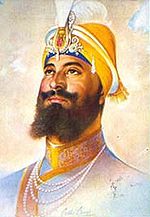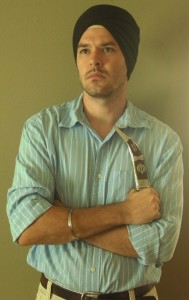I’m just going to come out and say it: Sikhs are bad-ass. Who else carries a blade or sword as an article of faith? Who else has a religion known for its peaceful disposition, yet has its own martial art (called Gatka)? Who else has an Army of God who’s sole mission is the defense of the weak, the poor, and the oppressed of ALL humanity?
The Sikhs…and not just any Sikh, but the Khalsa.
It’s never been easy, being a Sikh, especially during the time of the 10 gurus who shaped and developed the faith into the

religion we see today. This was never so bitterly true as during the time of the tenth and last human guru, Guru Gobind Singh. Guru Gobind Singh, like the Sikhs before him, faced great oppression and the threat of extinction at the hands of the Mughal emperors of India, who often persecuted Hindus, Sikhs, Buddhists, and other religious groups and forced them to convert to Islam. In the battles for religious/social freedom, Guru Gobind Singh lost all four of his sons: two in battle, the other two by execution after refusing to convert to Islam.
Guru Gobind Singh understood that only a society ready to defend itself and the oppressed stood any chance of survival, so he called Sikhs from all over the land to a meeting at Anandpur on March 30th, 1699. There, he asked the crowd who amoung them was willing to die (give their heads) for their faith. After asking three times, one man stepped forward and entered the tent with the Guru. The Guru later came out with a bloody sword and asked for another volunteer. Four more went into the tent. In the end, the five came out in new clothing.
They were called the Panj Piare, the “five beloved ones,” those willing to die for God and Guru. Guru Gobind Singh then took an iron bowl, mixed a bowl of sweetened water with a blade, and had each of the men drink from the bowl. He recited scripture from the Adi Granth (the collection of scripture before he completed the Guru Granth Sahib) and declared,
“Waheguru ja ka Khalsa! Waheguru ji ki Fetah!”
“Khalsa belongs to God. Victory belongs to God.”
Those five in turn performed the same initiation for Guru Gobind Singh, symbolizing equality and unity, and the Khalsa (meaning “pure”) was born.
Guru Gobind Singh then introduced what the Khalsa is and what they stand for:
“From now on, you have become casteless. No ritual, either Hindu or Muslim, will you perform nor will you believe in superstition of any kind, but only in one God who is the master and protector of all, the only creator and destroyer. In your new order, the lowest will rank with the highest and each will be to the other a bhai (brother). No pilgrimages for you any more, nor austerities but the pure life of the household, which you should be ready to sacrifice at the call of Dharma. Women shall be equal of men in every way. No purdah (veil) for them anymore, nor the burning alive of a widow on the pyre of her spouse (sati). He who kills his daughter, the Khalsa shall not deal with him.
Five K’s you will observe as a pledge of your dedication to my ideal.
- Kesh: a symbol of acceptance of your form as God intended it to be.
- Kangha: a comb, a symbol of cleanliness to keep one’s body and soul clean.
- Kara: a steel ring worn on the forearm, to inspire one to do good things by hand & desist from doing bad.
- Kacchera: a piece of undergarment reminding one to live a virtuous life and desist from rape or other sexual exploitation of women.
- Kirpan: a blade to protect oneself and other weak peoples from aggression.
Smoking being an unclean and injurious habit, you will forswear. You will love the weapons of war, be excellent horsemen, marksmen and wielders of the sword, the discus and the spear. Physical prowess will be as sacred to you as spiritual sensitivity. And, between the Hindus and Muslims, you will act as a bridge, and serve the poor without distinction of caste, colour, country or creed. My Khalsa shall always defend the poor, and ‘Deg’ – or community kitchen – will be as much an essential part of your order as Teg -the sword. And, from now onwards Sikh males will call themselves ‘Singh’ and women ‘Kaur’ and greet each other with ‘Waheguruji ka Khalsa, Waheguruji ki fateh (The Khalsa belongs to God; victory belongs to God).“
The die was cast. There was no longer a question of who the Sikhs were or what they stood for. Now easily distinguishable and set apart, they had matured and reached the heights of their spiritual/social mandate. Guru Gobind Singh’s pledge is the same Khalsa initiates (men and women) keep in mind today when they become “saint-soldiers,” which each Sikh takes very seriously.
Although I have not taken the Amrit baptism, I do honor my adopted Sikh brothers and sisters by wearing the “5 K’s” this month.
I am not just donning empty religious symbols. Each of the five K’s are heavily pregnant with meaning and utility. The turban (dastar) tames and keeps neat the Kesh (God-intended unshorn hair) and represents the pride/royalty of a Singh/Kaur or lion/princess. The Kirpan (blade) is a tool for the defense of myself and the oppressed around me. It also represents the sharp edge of the spiritually attuned, who can cut through ignorance. The Kara (steel bracelet), like a wedding band, represents commitment to God, the Guru, and humanity. I’ve also been told that, in defense, it can be used as a shield or even a brass knuckle in a pinch! The Kangha (comb) stands for the honor and cleanliness of a Sikh (Sikhs keep this in their wrapped hair). And finally, the Kacchera (under-shorts) stands for chastity and was also a battle implement for riding horseback in battle. You can’t see mine, nor will you ; )
Honestly, I feel different wearing these. I feel the tinge of pride, a kind of nobility. Sure, people stare at me now, but I feel like I’m representing something higher than myself and therefore my back is a little straighter, my head a little higher, and my awareness of why I wear these, a little stronger. My only hope is that I bear the Sikh title well and that others see the wonder of the Sikhi path through my brief example.


